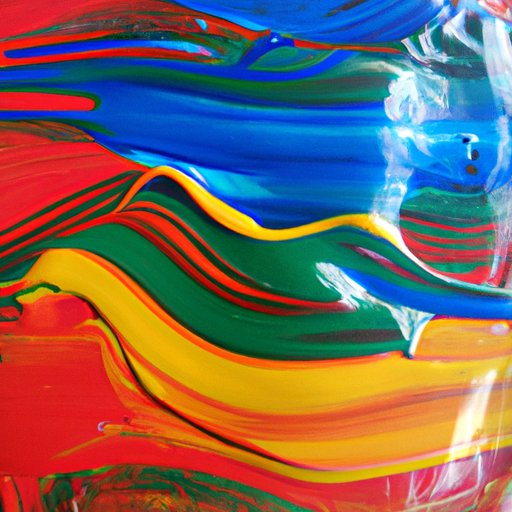Introduction
Acrylic paint was first developed in the 1940s but wasn’t widely used until the 1960s. The main ingredient in acrylic paint is an acrylic polymer emulsion, which is a water-soluble, synthetic resin. This type of paint dries quickly, is waterproof when dry, and is known for its vibrant colors and durability. The acrylic polymer emulsion plays a crucial role in how the paint behaves, giving it its unique properties and versatility.
Acrylic Painting Techniques
There are several painting techniques you can use with acrylic paints. These include layering, blending, dry brushing, impasto, and more. Here is a breakdown of each:
Layering
Layering is a technique where you apply paint in thin layers, building up the colors gradually to create depth and texture. You can use this method with a brush, palette knife, or even your fingers. It’s a great technique for creating complex and intricate paintings.
Blending
Blending is a technique where you mix two or more colors together to create a smooth transition between them. You can use this technique to create gradients, shadows, and highlights. You can blend colors by using a dry brush or sponge, or by applying wet paint onto wet paint.
Dry Brushing
Dry brushing is a method of applying paint to create a rough or textured effect. You use very little paint on the brush and apply it quickly and lightly over the surface of the painting. This is a great technique for creating a vintage or weathered look.
Impasto
Impasto is a technique where you apply thick layers of paint to create a three-dimensional effect. You can use a palette knife to apply the paint, creating textures and depth. This technique is great for creating bold and textured paintings.
Each of these techniques can be combined and experimented with to create unique effects in your paintings. Try them out and see what works best for you!
Mixing Acrylic Paint
Before you start painting, it’s important to understand color theory and how it applies to mixing acrylic paint. The three primary colors are red, blue, and yellow. These can be mixed together to create secondary colors: orange, green, and purple. To create tertiary colors, you mix a primary color with a secondary color.
To mix colors properly, start with the lightest color and gradually add the darker color until you reach the desired shade. It’s important to mix enough paint for your project, as it can be difficult to match the same color again later if you run out. You can mix acrylic paints on a palette or directly on the canvas.
When mixing colors, avoid overmixing as this can lead to a dull, grayish tone. If you need to adjust the hue or make the color lighter, add white paint. To make the color darker, add black paint. Avoid using too much black paint, as it can make the color look muddy.
Pros and Cons of Acrylic Paint
Acrylic paint has many advantages, including its quick drying time, durability, and vibrancy. It’s also water-soluble, making it easy to clean up. Acrylic paint is a great choice for beginners, as it’s easy to work with and forgiving. However, there are some disadvantages to using acrylic paint. It dries quickly, which can make blending difficult. It’s also more difficult to achieve the same level of detail as oil paints.
When deciding whether to use acrylic paint, consider the project you’re working on and what you want the final outcome to be. For larger projects where you need to work quickly, acrylic paint is a great choice. If you’re working on a detailed portrait or landscape, you may want to consider using oil paints.
Best Acrylic Paint Brands
There are many great brands of acrylic paint on the market. Each brand has its strengths and weaknesses, so it’s important to choose the right one for your project. Here are some of the best brands:
Golden
Golden is one of the most popular brands of acrylic paint. It has a high pigment load, which means the colors are vibrant and long-lasting. Golden also offers a wide range of mediums, which can be used to create different effects.
Winsor & Newton
Winsor & Newton is a well-established brand that has been around for over 180 years. Their acrylic paint is high-quality and available in a range of colors. They also offer a range of mediums and varnishes to enhance your paintings.
Liquitex
Liquitex is another popular brand of acrylic paint. They offer a wide range of colors, including iridescent and fluorescent options. Their paint is also versatile and can be used on a variety of surfaces.
Acrylic Paint Applications
Acrylic paint is not just for canvas. It can be used on a variety of surfaces to create unique and creative projects. Here are some ideas:
Canvas
Canvas is the most popular surface for acrylic painting. It’s durable and easy to work with. You can create large or small paintings on canvas.
Wood
Wood is another great option for acrylic painting. You can paint onto wood objects, such as tables, chairs, or picture frames.
Pottery
Acrylic paint can be used to decorate pottery. You can paint designs onto plates, vases, or bowls.
Fabric
Acrylic paint can be used to paint onto fabric. You can create custom t-shirts, tote bags, and more. Mix fabric medium into the paint to help it adhere to the fabric and to make it more flexible.
Each of these applications requires different techniques and processes, but they can all be achieved with acrylic paint.
Conclusion
Acrylic paint is a versatile and exciting medium that can be used for a variety of projects. Whether you’re a beginner or an experienced painter, there’s always something new to learn when it comes to acrylic paint.
